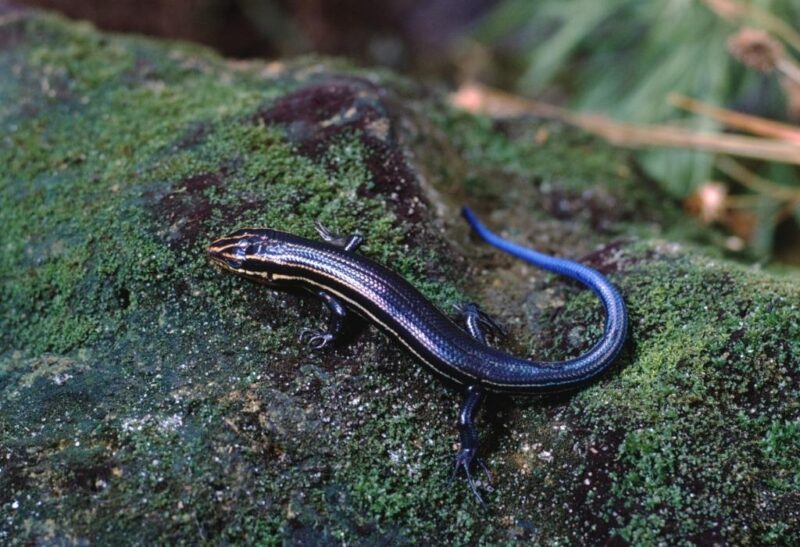If you are searching for fascinating lizards, it is worth checking out the most common lizards in Florida. This beautiful sunny state is home to diverse lizard species that will surely catch your interest.
What are the most common lizards in Florida? Some of the most adorable and common lizards in Florida are the Green Anole, Florida Scrub lizard Sceloporus woodi, Florida Sand Skink Plestiodon reynoldsi, etc. Most of these species possess bright colors that can camouflage with their surroundings to protect themselves against predators, such as birds and snakes.
By reading this guide further, you will encounter extensively other common lizards in Florida, their characteristics, and many more. So, let’s get this started!
Table of Contents
17 Most Common Lizards in Florida
Florida Scrub Lizard (Sceloporus Woodi)

The Scrub lizard, scientifically known as Sceloporus woodi, is relatively small and heavily built. This species is usually found in dry habitats, such as the grasslands, farm fields, and sandhills of central Florida.
The color of these lizards ranges from brown, tan, and gray with a dark brownish-orange streak per side of the body. This line runs from the bottom of the neck to the beginning of the tail.
The males of this species own an aqua line and shoulder patches, while females own several wavy streaks. These lizards mainly feed on small arthropods, ants, spiders, beetles, etc.
These lizards can be purchased online starting from $32.99 and above.
- Appearance: The Florida scrubs are small lizards with gray to a gray-brown color and spiny scales. Adults are approximately 5 inches long with a thick brown line, running down on each body side that starts from the neck to the tail’s base.
- Color: Brown, tan, gray
- Lifespan: 2.3 years
- Size: 4 inches to 5 inches in length
- Weight: Unknown
- Diet: Spiders, insects, and other tiny arthropods
- Place Of Origin: Florida
- Characteristics: Scrub lizards are small, gray to grayish brown lizards that are primarily active during warm days year-round. These lizards mainly search for food on the ground and perch on tree trunks’ bases and on logs to catch their prey.
Eastern Fence Lizard (Sceloporus Undulatus)

The Eastern Fence lizard is a small and plain lizard species. Their color varies from light gray, yellowish-tan, or almost black.
These lizards have a distinct row of W-shaped dark stripes on their backs, with each line rimmed with a lighter shade at the edge. Males have vibrant aqua patches on two sides of their underbellies and throats.
Though these Eastern Fence Lizards have a similar appearance to brown anoles, they own much larger heads and shorter tails. These lizards eat beetles, ants, grasshoppers, moths, stinkbugs, etc.
These lizards are not generally aggressive unless protecting their territories, making them a good pet. However, you must ensure to build a habitat similar to their natural one for them to thrive.
You can buy an Eastern Fence lizard starting at $19.99.
- Appearance: Eastern Fence lizards are medium-sized, broad-bodied grayish to brown lizard species with pointed scales. Females are much bigger than males, with dark, wavy stripes across their backs. Meanwhile, males have a uniform color with glowing blue patches rimmed with black on bellies and throats.
- Color: Brown, gray, yellowish-tan, and pale black
- Lifespan: 5 years
- Size: 4.0 inches to 7.25 inches in length
- Weight: 15 grams
- Diet: Ants, moths, beetles, spiders, grasshoppers, and stink bugs
- Place Of Origin: South Carolina and Georgia
- Characteristics: Eastern Fence lizard males are territorial with bright blue belly tints, used to warn other males to withdraw. These lizards will also display push-ups and head bobs to protect their territory.
Ground Skink (Scincella Lateralis)
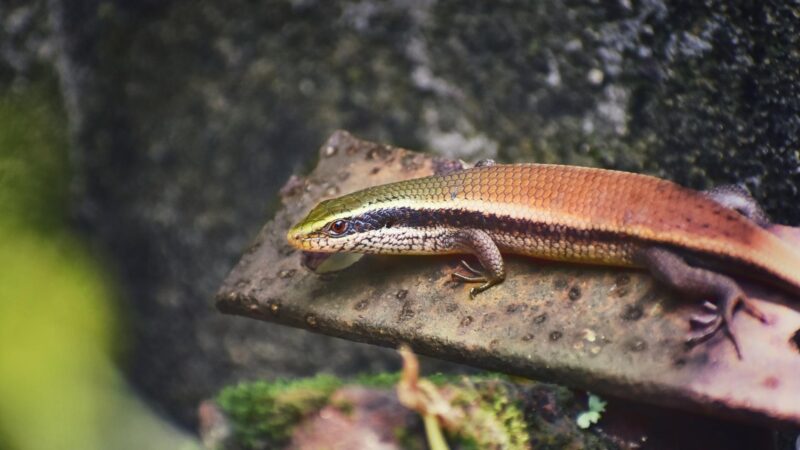
Ground skinks are tiny, slim lizards with short legs and long tails. Their color ranges from almost black to golden brown color.
Nonetheless, most often these lizards have coppery brown bodies with darker streaks running on each side of the body. In addition, their bellies are yellowish or white.
Ground skinks can be found throughout South Carolina and Georgia. These spiders favor spots with many leaf debris and loose soil.
Instead of running using their minuscule legs, ground skinks utilize their thin bodies to crawl through leaf litter or loose soil. Their diet comprises insects, isopods, spiders, and other invertebrates.
These lizards can be good pets as long as they are properly cared for since they are very active. You can buy ground skinks online for less than $10 each.
- Appearance: Ground skinks are little, thin lizard species with short legs and long tails. Their color ranges from pale black to golden brown but is often coppery-brown in color, with a darker line on each body side with yellowish and white bellies.
- Color: Golden brown, pale black with a bronze shade
- Lifespan: 2.5 years
- Size: 3 inches to 5.5 inches
- Weight: Unknown
- Diet: Tiny insects, spiders, other invertebrates, and isopods
- Place Of Origin: Australia
- Characteristics: Ground skinks have the usual lizard body shape but with short legs, short, dark necks, and lengthy tapering tails. Most males of this species depict red or orange markings every breeding season.
Florida Sand Skink (Plestiodon Reynoldsi)
The Florida Sand Skink, scientifically known as Neoseps renoldsi, has almost the same snake-like appearance as a glass lizard. However, unlike glass lizards, it has small arms and legs.
The front limb has one toe, while the back limb bears two. These lizards have gray to light-brown color, with light and dark spots, allowing them to camouflage easily to sandy habitats.
Unlike other lizards, this species can’t be kept as pets since they spend most of their time underground.
- Appearance: The sand skink is a tiny, slim, gray to light brown species of lizards with shiny scales, reaching up to 5 inches long. These lizards also have only one toe on their front limb and two on the hind.
- Color: Gray, light-brown
- Lifespan: 8 years to 10 years
- Size: 3 inches to 5 inches
- Weight: Unknown
- Diet: Invertebrates, including termites, spiders, beetles, and antlions larvae.
- Place Of Origin: Central Florida
- Characteristics: Sand skinks possess little eyes and wedge-shaped noses with no outward ear openings.
Broadhead Skink (Plestiodon Laticeps)
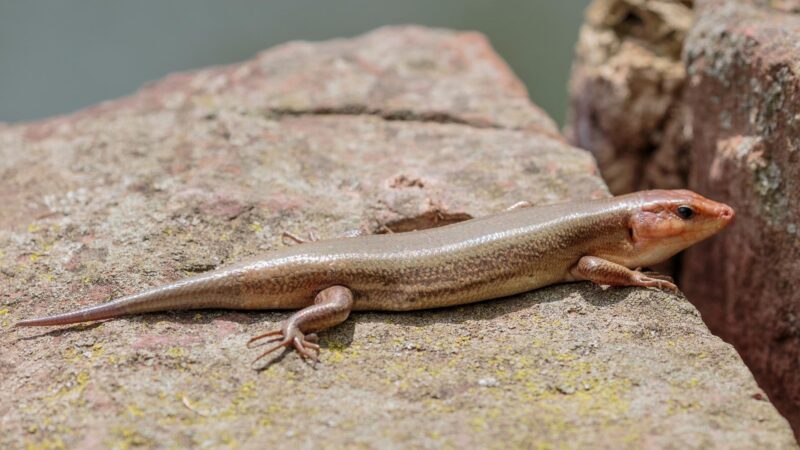
The Broadhead Skink is the biggest species of skink in Florida. These lizards are big enough to catch and feast on other lizards occasionally.
Typically, broadheads can be found in suburban and urban areas of northern Florida that are close to tree groves, parks, and gardens. Adults are color brown, with light black streaks along their patternless sides and backs.
These lizards are among the species that are best kept as pets since they are exceptionally easy to take care of. In addition, these lizards eat foods that are very easy to get, such as spiders, various insects, mollusks, invertebrates, small reptiles, and young rodents.
You can purchase this species online or at your local pet store at an average price of $49.99.
- Appearance: Broadhead Skink lizards own glossy bodies with tiny scales all over. Males are more colorful than females, having shiny olive-brown to deep brown skin. Meanwhile, females have five soft lines on their backs to their tails. Their heads change to bright reddish-orange color every mating season.
- Color: Dark brown, black
- Lifespan: 8 years
- Size: 6 inches to 13 inches
- Weight: 70 grams (Average adult weight)
- Diet: Insectivores, but also feed on rodents, mollusks, and small reptiles
- Place Of Origin: Southeastern United States
- Characteristics: Broad-headed skinks are usually more active during the day. These lizards are mostly found in trees but frequently hunt and nest on the ground. It’s also best to note that males are highly territorial, particularly every breeding season, chasing away smaller male lizards.
Southeastern Five-lined Skink (Plestiodon Inexpectatus)

The Southeastern Five-Lined Skinks are among the most common lizards you can find in Florida. These lizards are often seen lolling on sidewalks, patios, or fence posts in urban and suburban sites.
The juvenile lizards are black in color with blue tails. Meanwhile, adults are dark brown to black in color with cloudy orange heads.
This species can be determined with its distinct five white streaks, running down from its back and fading away at the tail area. The Southeastern Five-Lined Skinks are popular house pets and can be purchased online at $11.99 each.
- Appearance: Southeastern five-lined skinks are relatively big lizards with short legs. Their bodies are generally brown, gray, or black with five yellowish or white lines.
- Color: Gray, black, brown
- Lifespan: 6 years (wild), 10 years (captivity)
- Size: 5 inches to 8.5 inches
- Weight: 0.47 grams to 0.81 grams
- Diet: Insectivores, but also eat frogs, spiders, and snails
- Place Of Origin: South Carolina and Northern Georgia
- Characteristics: These lizards are quite known for their five yellow or white streaks that run down from their nose to their tail. The rest of the body’s color can range from olive, brown, and black but tend to lighten when they start to age.
Common Five-lined Skink (Plestiodon Fasciatus)

Five-lined skinks are medium-sized lizards from North America with short legs and generally brown, gray, or black color. These lizards have five yellowish or white with two streaks on each side and one at the back’s center.
The young common five-lined skink has a bright blue tail, while adult males lose their streaks and form an orange or reddish color on the head. This species has the same look as the broadhead skink but is relatively smaller.
These lizards can also make good pets, but they must be provided with good housing, substantial food, and water. Proper care and handling are also highly advised.
- Appearance: The Common Five-lined Skink is a small gray to a black lizard with five cream lines along its back. These lines will fade as they age. Another thing to note about this species is that the males possess an orange tint around the jaws and tint during the breeding season.
- Color: Brown, olive
- Lifespan: 6 years
- Size: 5 inches to 5.8 inches
- Weight: 0.47 gram to 0.81 gram
- Diet: Insectivores—mainly feed on millipedes, spiders, termites, crickets, caterpillars, beetles, grasshoppers, and beetle larvae. In addition, these lizards also eat snails, smaller lizards, frogs, and newborn mice.
- Place Of Origin: North America
- Characteristics: American five-lined skinks are typically solitary lizards but hibernate in smaller groups every winter. Adult males display aggressive and complex courtship behavior. Nonetheless, adult males tolerate females and juveniles in their domains but actively safeguard their extents against other males.
Mole Skink (Plestiodon Egregious)
Mole skinks can be found throughout eastern and southern Georgia. Living up to their title, these lizards are apt at tunneling and prefer locations with loose sandy soil.
These lizards generally favor drier and hotter places than other ground skinks. You can usually find mole skinks beneath logs, boards, leaf litter, and other covering objects.
Moles skinks mostly eat spiders, roaches, crickets, etc. They have a calm temperament, making them one of the most ideal lizards as pets. Prices vary per species but range from $150 to $250 each. The rarer the forms, the more expensive they will be.
- Appearance: Mole skinks are little, thin lizards with short legs and long tails. Their color ranges from grayish to brown, with two light streaks on each body side and an orange or red tail that does not fade with age.
- Color: Grayish to brown
- Lifespan: 2 years to 3 years
- Size: 3.5 inches to 6 inches long (adult)
- Weight: 10 ounces to 18 ounces
- Diet: Spiders, tiny insects, and other invertebrates
- Place Of Origin: Southeastern United States
- Characteristics: Mole skinks have brown bodies with pinkish-colored tails. Two or more light-tinted streaks can also be seen extending from their head to the rest of their body.
Coal Skink (Plestiodon Anthracinus)
The Coal skink is one of the common medium-sized lizard species in Florida that prefer living in rural zones away from development. Their colors range from brown to black, with four pale stripes and two dark stripes found between the pair of light lines.
These lizards primarily feed on arthropods, including termites, earthworms, ant larvae, and pupae. Coal skinks are great reptile pets for beginners since they are docile, gentle, quiet, and can easily be tamed.
You can purchase this lizard at a local pet store or online with a price ranging from $150 to $250.
- Appearance: The coal skink is a medium-sized lizard with short legs and smooth, glossy scales. Their back part color ranges from brown to olive-gray. These lizards also have a broad, black sideways streak extending from the head to the tail. It’s then rimmed by a thin pale stripe above and below.
- Color: Brown, olive-gray
- Lifespan: 2 years to 3 years
- Size: 5 inches to 6 inches long
- Weight: Unknown
- Diet: Arthropods (termites, earthworms, and ant larvae and pupae)
- Place Of Origin: North America
- Characteristics: Coal skinks are medium-sized lizard species with short legs and slick bodies. Their bodies are generally gray to brown, with four yellowish or whitish stripes on each side.
Eastern Glass Lizard (Ophisaurus Ventralis)
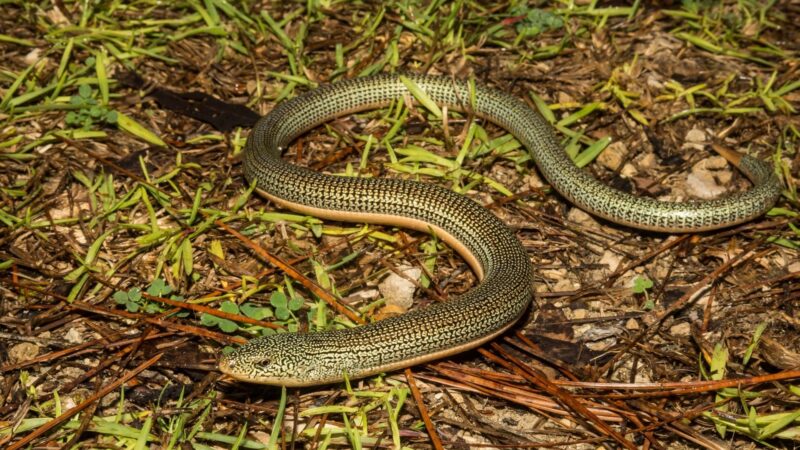
Eastern glass lizards are commonly found throughout the sandy areas of Coastal Plain and in eastern and southern parts of Georgia and South Carolina. Although these lizards can be found in various habitats, but are most common in wetlands and flatwoods in sandy habitats.
In addition, the eastern glass lizards are much more common in coastal dune areas and are even seen beneath any debris at the tide line. These lizards forage actively during the day in open habitats.
However, they can be commonly seen taking refuge underneath boards and other residues.
If you’re thinking of getting this species as a pet and it’s your first time, it’s not advisable. This is because there’s not much info about this species, so it’s best left to keepers with experience.
You can find these lizards for sale online, generally at $24.99.
- Appearance: Glass lizards are long, legless, slim lizards superficially resembling snakes. The difference these lizards have from snakes are their outer ear openings, moveable eyelids, and stiff jaws.
- Color: Greenish-yellow (Adult), Khaki (Juvenile)
- Lifespan: 10 years
- Size: 18 inches to 43 inches
- Weight: 21 ounces
- Diet: Insects, spiders, other invertebrates, small reptiles, and probably young rodents
- Place Of Origin: Eastern United States
- Characteristics: Glass lizards are without legs, making you mistake them for snakes. This characteristic made these lizards unique. They also own long and slender bodies with glossy scales.
Mimic Glass Lizard (Ophisaurus Mimicus)
Mimic glass lizards are among the common lizards in Florida that originate in Southern Georgia and South Carolina. These lizards prefer to live in dry habitats and flatwoods.
They are active in foraging during the day in open habitats but are mostly seen hiding underneath panels and other debris. Just like other glass lizards, their diet involves spiders, insects, and invertebrates.
These lizards can also be good pets as long as handled well. You can purchase this species online or in a pet store, usually at $25.
- Appearance: Mimic glass lizards are among the smallest glass lizards with brown to tan color. These lizards also own a black or deep brown mid-dorsal streak.
- Color: Brown, yellow
- Lifespan: 10 years
- Size: 15 inches to 26 inches long
- Weight: 11 ounces to 21 ounces
- Diet: insects, spiders, and other invertebrates
- Place Of Origin: Southern Georgia and South Carolina
- Characteristics: Glass lizards are long, limbless, slim lizard species resembling snakes. Nonetheless, these lizards have stiff jaws, outer ear openings, and moveable eyelids, separating them from snakes.
Slender Glass Lizard (Ophisaurus Attenuates)
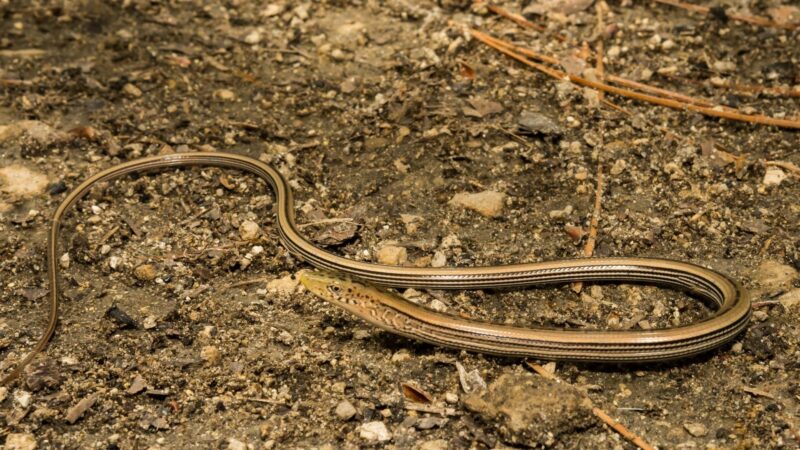
Slender glass lizards originated from Georgia and South Carolina but are the most common sight in sandy Coastal Plain areas. These lizards prefer to settle in drier habitats than in sandhills or old fields that the eastern glass lizards preferred.
This species is best determined by its dark markings underneath the sideway groove. However, it’s best to note that these markings are dimmed in older individuals.
Slender glass lizards mostly eat invertebrates, spiders, insects, small rodents, and young reptiles. They can be good pets if treated and handled well.
The price of these lizards varies, but you can get one at around $29.99 each.
- Appearance: The slender glass lizard can have a bronze, brown, or tan body color with a black or deep brown colored line that runs from the center of its back down to the tail.
- Color: Bronze, brown, tan
- Lifespan: 10 years
- Size: 29.5 inches
- Weight: 15 grams
- Diet: Insectivores—these lizards eat crickets, grasshoppers, and beetles. On top of that, they also consume small rodents, spiders, and snails.
- Place Of Origin: South Carolina and Georgia
- Characteristics: These slender lizards possess a brown or yellow back with six longitudinal streaks, including a distinctive mid-dorsal line, and are typically skittish when threatened.
Island Glass Lizard (Ophisaurus Compressus)
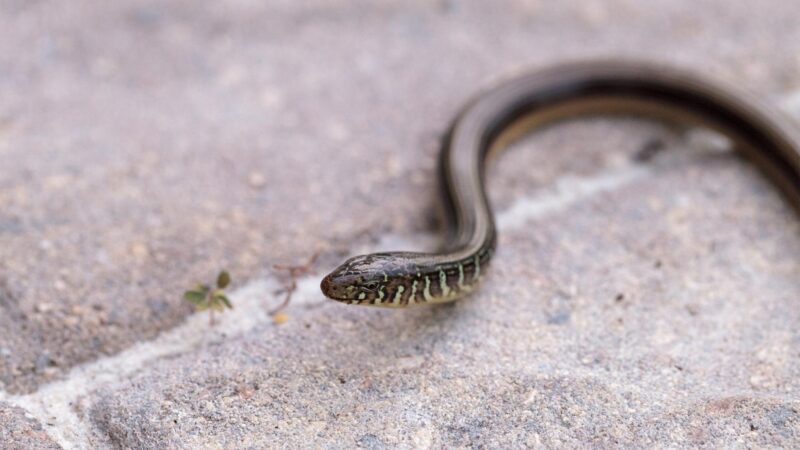
As their name implies, the Island glass lizards are often seen on offshore islands, particularly along the southern Georgia and South Carolina coast. They prefer living in drier habitats and are frequent in sandy scrub areas.
These lizards are active foragers by day but can also be active during the early evening. Island glass lizards primarily consume crickets, moth larvae, spiders, caterpillars, roaches, etc.
If you are thinking of petting this species, you can get one starting at $50 or higher.
- Appearance: Like other glass lizards, these species possess long, slim, and limbless bodies, just like snakes. The island glass lizard is best discerned from other glass lizard species with a single dark streak beneath each body side.
- Color: Yellowish to brown
- Lifespan: 10 years
- Size: 18 inches to 43 inches
- Weight: 11 ounces to 23 ounces
- Diet: Various insects, spiders, young rodents, and small reptiles
- Place Of Origin: Asia, Europe, and North America
- Characteristics: Glass lizards are limbless lizards with glossy scales covering their bodies—similar to snakes. But, unlike snakes, these lizards own round pupils and moveable eyelids that dilate at the sun’s presence.
Green Anole (Anolis Carolinensis)
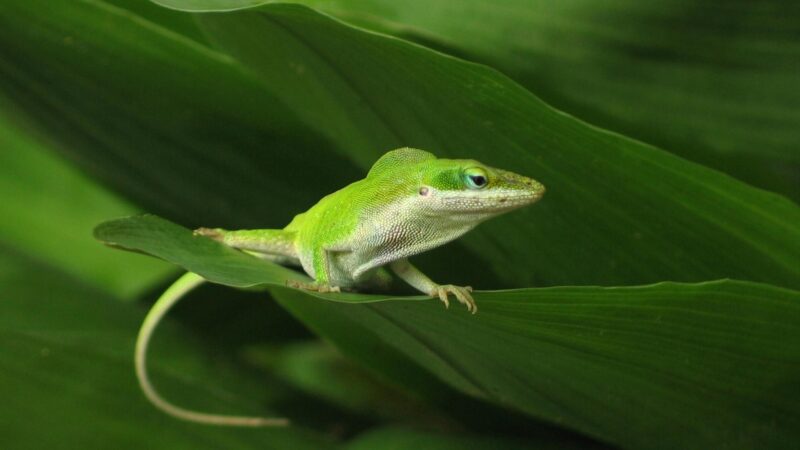
The green anole is among Florida’s most common lizards. They have bright, lime-green-colored bodies with white underbelly and throats.
However, when these lizards are cold or stressed, their color will shift to dark brown while preserving their white throat spots. The male green anoles own a pink dewlap and long fingers with white speckles.
These lizards display their pink dewlap while performing a head-bobbing motion to entice mates.
You can buy these lizards starting at $10 each. However, note that males are particularly territorial, so it’s worth considering keeping them alone or in a very small group.
- Appearance: The green anole lizards can grow up to five to eight inches and have sharp noses, slender bodies, narrow heads, and long, slender tails. These lizards have long hind legs, white lips and bellies, and moveable eyelids.
- Color: Bright green, greenish-brown to dark brown
- Lifespan: 6 years
- Size: 5 inches to 8 inches
- Weight: 2 grams to 6 grams
- Diet: Crickets, waxworms, or mealworms
- Place Of Origin: Southeastern United States
- Characteristics: These lizards are particularly skittish. However, with constant and delicate handling, they can somehow be tamed. Anoles are exceptionally active lizards, scampering fast, causing them challenging to catch.
Six-lined Racerunner (Aspidoscelis Sexlineatus)
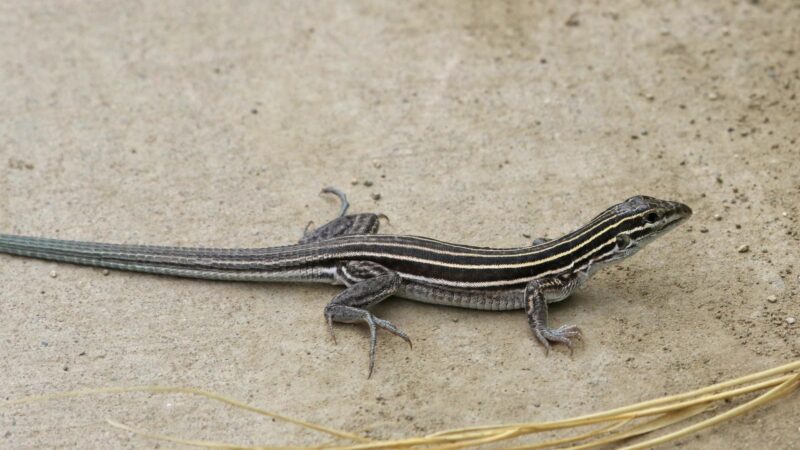
The Six-Lined Racerunners are speedy lizards native to Mexico and the United States. They own long, slim bodies with a tail twice their body size.
These species have a black body with a whitish throat and belly that are occasionally tinged with blue in males. Both sexes have six yellowish stripes running from the snout’s tip, down to the tail.
They eat various spiders, insects, and other invertebrates. You can purchase this species online starting from $29.99 if you are planning to keep a lizard as a pet.
But, before buying one, it’s best to note that this species can be aggressive with other lizards, so it’s best to be kept alone.
- Appearance: These lizards can be determined from other lizards by the six narrow and distinct yellow or white streaks unfolding from the head’s back to around one-third of their tail. There are also rectangular and flat scales positioned in eight rows on their bellies with little grainy non-overlapping scales.
- Color: Dark brown, black
- Lifespan: 4 years to 5 years
- Size: 3 inches to 8 inches
- Weight: 7.1 ounce
- Diet: Invertebrates, insects, and spiders
- Place Of Origin: Mexico and the United States
- Characteristics: The Six-lined Racerunners are slender lizards with pointed noses and extremely long tails. The color of these lizards can vary from black, brown, gray, or olive, with six gray, yellowish-green, pale blue, or white stripes on both sides of their back.
Brown Anole (Anolis Sagrei)
The Brown Anole is an invasive type of lizard, usually tan, brown, and gray in color with cream-colored bellies. In addition, these lizards also possess dark streaks steering down their backs, but these can be difficult to see.
The diet of these lizards includes grubs, various insects, mealworms, fish, spiders, etc.
Brown anole can be bought online from $5 to $10. These lizards can be great pets since they are very easy to take care of, even for first-time keepers.
- Appearance: Brown anoles generally are grayish to brown in color, with a yellowish or whitish pattern on the back. Males usually have a red or orange throat fan with white edging.
- Color: Grayish to brown
- Lifespan: 5 years
- Size: 9 inches
- Weight: 3 grams to 4 grams
- Diet: Insects, mealworms, grubs, spiders, smaller lizards including eggs, fish, and aquatic invertebrates
- Place Of Origin: Cuba, Caribbean, and Bahamas
- Characteristics: Brown Anoles are mid-sized and relatively hardy lizards covered in small scales. They have notably shorter noses than other anoles but possess the same long tails and claws.
Bluetail Mole Skink (Plestiodon Egregious)
The Bluetail mole skinks are small lizard subspecies with glossy brownish to pink bodies and blue tails, originating from Central Florida. These lizards heavily rely on spiders, roaches, and crickets as their primary diet.
They also love burrowing in loose sand, so these lizards typically live in sandhills, sand pine scrubs, turkey oak barrens, etc. You can find these lizards for sale online, starting from $9.99.
- Appearance: Bluetail mole skinks have a brownish body with a blue tail that can turn orange or pink as these species get older or when their tail is regenerated.
- Color: Brown with blue tail
- Lifespan: 5 years to 7 years
- Size: 5 inches
- Weight: 10 ounces to 18 ounces
- Diet: Spiders, roaches, and crickets
- Place Of Origin: Central Florida
- Characteristics: The blue-tailed mole skinks are carnivorous. They primarily eat various insects, slugs, spiders, and other tiny pests in the garden.
Frequently Asked Question
What Is the Most Common Lizard Type in Florida?
The most common type of lizard in Florida isn’t singular. It involves a wide range of lizard species like the brown anole, green anole, six-lined racerunners, and the rest listed above.
The existence of these lizards is very common in Florida, so you can always check them out whenever you decide to pet one.
Can Florida Lizards Hurt You?
Lizards are considered harmless creatures. This is because Florida’s lizards are not venomous, but it’s best to note that these can still bite when threatened, which can still cause an infection.
Are Any Lizards Poisonous in Florida?
As of writing, there are no known venomous lizards in Florida. However, they can carry bacteria and infections when they bite.
Summary
The sunny country of Florida is a terrific state for viewing lizards, such as listed above. If you’re planning to travel to Florida, you can start making a list as to where these lizards live—but this can’t be hard since you will most likely see these creatures on city parks or treetops during your trip.
List of Sources
Enge, K. M., Branch, L. C. (2019). Florida Scrub Lizard (Sceloporus Woodi). University of Florida.
Eastern Fence Lizard. Tennessee Wildlife Resources Agency.
Little Brown Skink. Missouri Department of Conservation.
Southeastern Five-lined Skink (Eumeces [Plestiodon] inexpectatus). University of Georgia.
